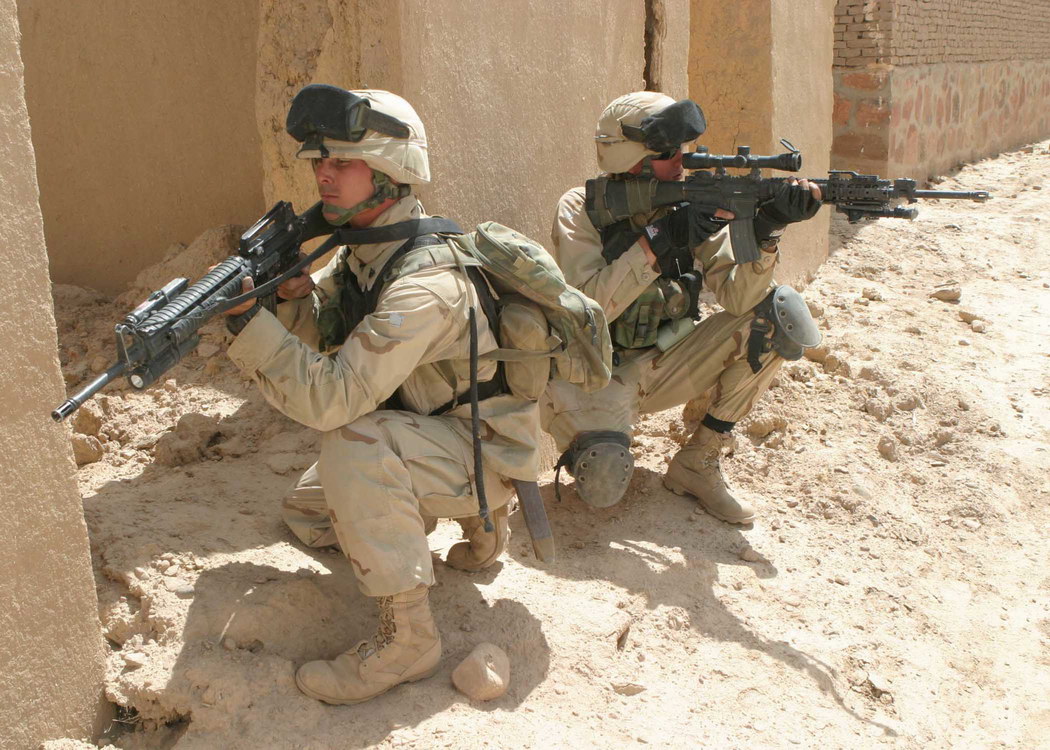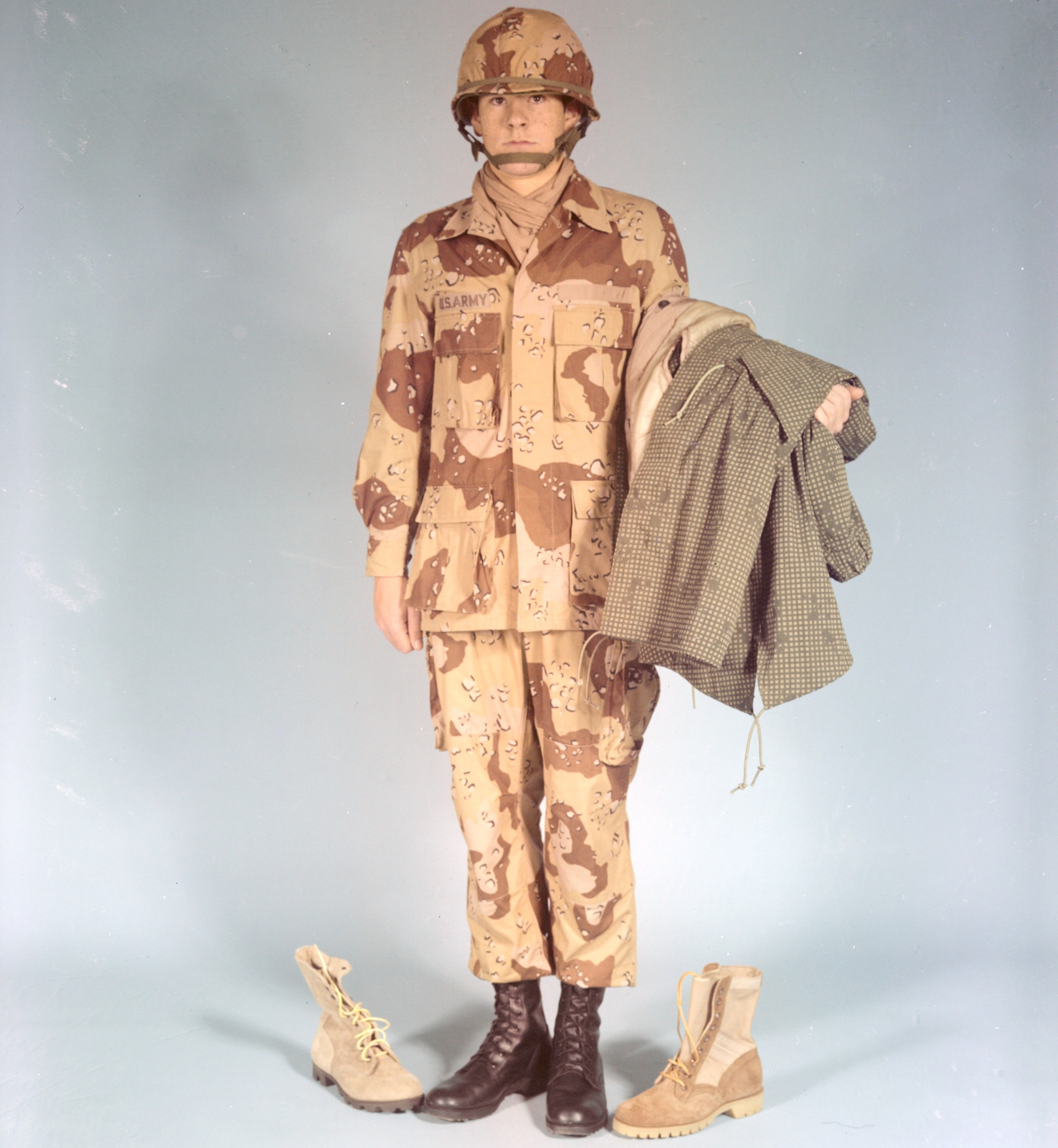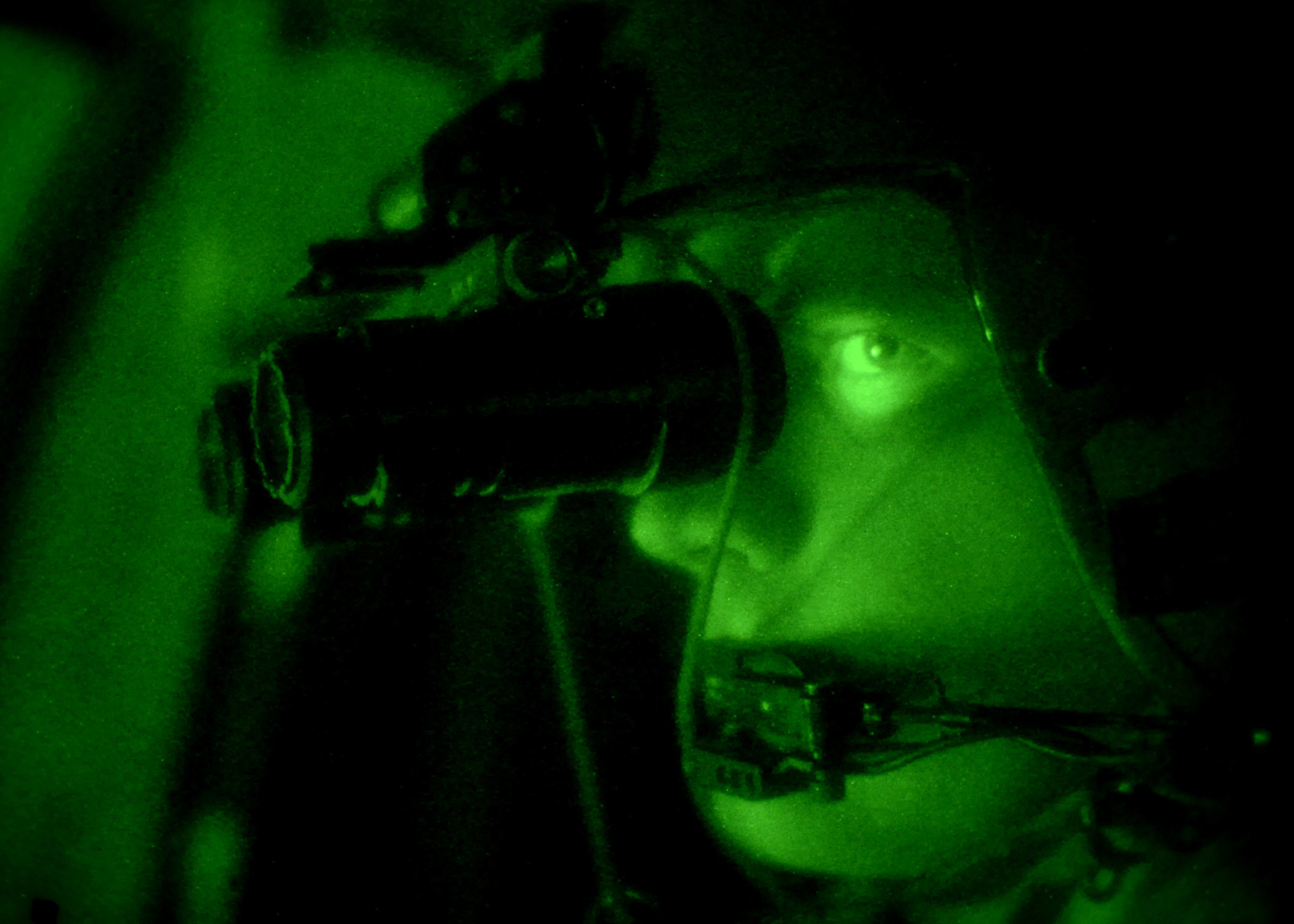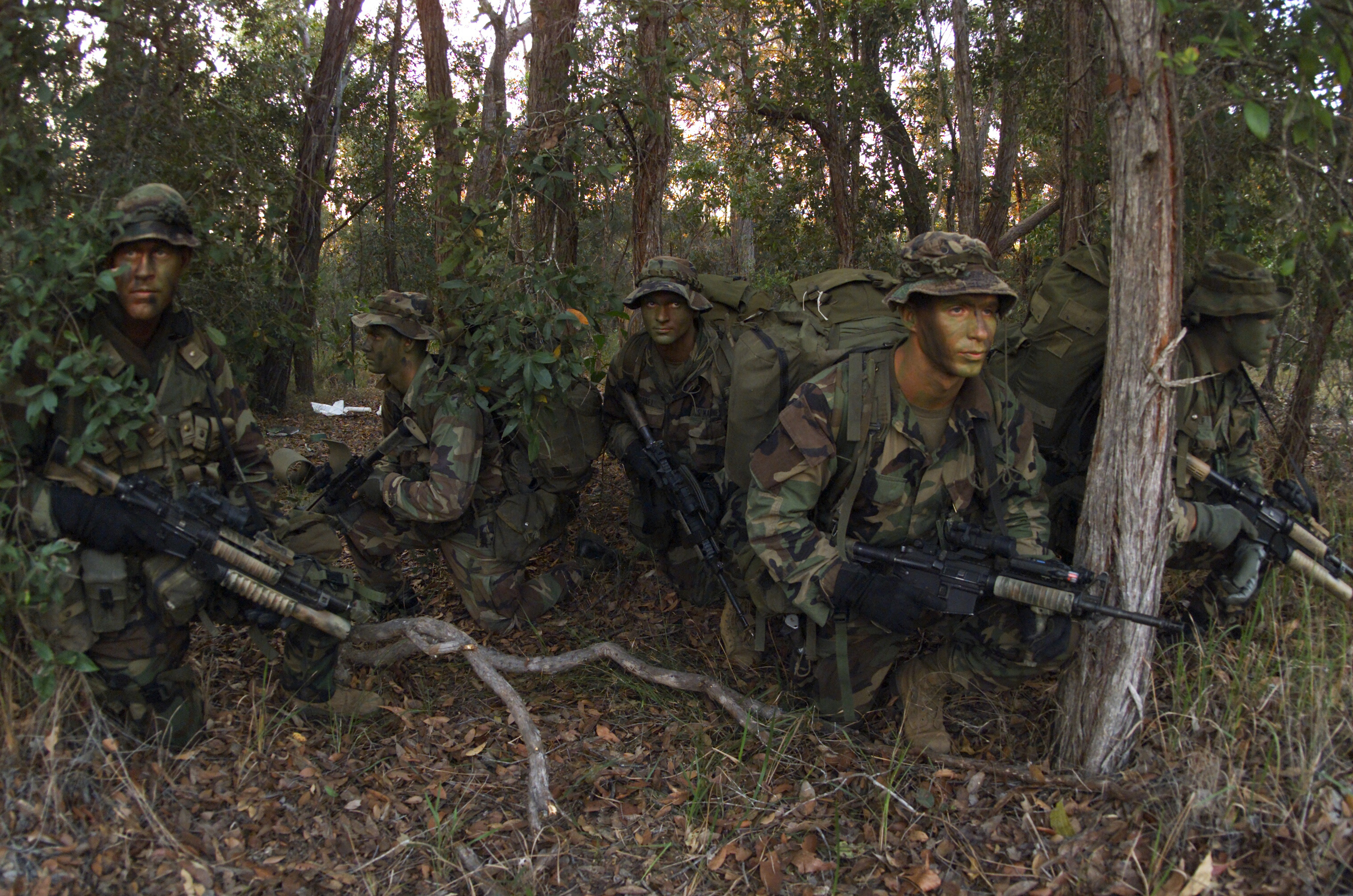|
Desert Night Camouflage
The Desert Night Camouflage pattern is a two-color grid camouflage pattern used by the United States military during the Gulf War. It was designed to aid soldiers in concealment from Soviet-based night vision devices (NVDs). The pattern is now considered obsolete due to the increase in capability of foreign night vision devices. Even with the pattern being obsolete, it has gained interest due to its unusual look. History The earliest photos of this camouflage pattern are dated to 1972, and field tests occurred in 1976. Distribution of garments in the Desert Night pattern started in 1981, however, was in limited numbers. During the Persian Gulf War, clothing sets in this pattern were issued in wider numbers to US soldiers and marines. Sets of parkas and trousers were intended to be worn over the issued six-color Desert Battle Dress Uniform during nighttime operations. No replacement for a night-specific desert pattern has been created, as advancements in infrared reflectan ... [...More Info...] [...Related Items...] OR: [Wikipedia] [Google] [Baidu] |
Military Camouflage
Military camouflage is the use of camouflage by an Military, armed force to protect personnel and equipment from observation by enemy forces. In practice, this means applying colour and materials to military equipment of all kinds, including vehicles, ships, aircraft, gun positions and battledress, either to conceal it from observation (crypsis), or to make it appear as something else (mimicry). The French slang word ''wikt:camouflage, camouflage'' came into common English usage during World War I when the concept of visual deception developed into an essential part of modern military tactics. In that war, long-range artillery and observation from the air combined to expand the field of fire, and camouflage was widely used to decrease the danger of being targeted or enable surprise. As such, military camouflage is a form of military deception in addition to cultural functions such as political identification. Camouflage was first practiced in simple form in the mid 18th centur ... [...More Info...] [...Related Items...] OR: [Wikipedia] [Google] [Baidu] |
M-1965 Field Jacket
The M-1965 field jacket (also known as M65, M-65 field jacket, and Coat, Cold Weather, Man's Field), named for the year it was introduced, is a popular field jacket initially designed for the United States Army under the ''MIL-C-43455'' standard by Alpha Industries. It was introduced into U.S. military service in 1965 to replace the previous M-1951 field jacket, itself an improvement on the M-1943 field jacket introduced during World War II, although the M-51 continued to be issued for quite some time. The M65 field jacket was widely used by United States forces during the Vietnam War in which the jacket became useful for troops serving in the Central Highlands of South Vietnam due to its wind and rain resistance, especially in the monsoon season and after. It was a standard issue to US troops in several other wars all around the globe as well, due to its long service life. Variations of the jacket are used in countries like Austria or South Korea. The jacket has also been pro ... [...More Info...] [...Related Items...] OR: [Wikipedia] [Google] [Baidu] |
United States Military Uniforms
United may refer to: Places * United, Pennsylvania, an unincorporated community * United, West Virginia, an unincorporated community Arts and entertainment Films * ''United'' (2003 film), a Norwegian film * ''United'' (2011 film), a BBC Two film * ''The United'' (film), an unreleased Arabic-language film Literature * ''United!'' (novel), a 1973 children's novel by Michael Hardcastle Music * United (band), Japanese thrash metal band formed in 1981 Albums * ''United'' (Commodores album), 1986 * ''United'' (Dream Evil album), 2006 * ''United'' (Marvin Gaye and Tammi Terrell album), 1967 * ''United'' (Marian Gold album), 1996 * ''United'' (Phoenix album), 2000 * ''United'' (Woody Shaw album), 1981 Songs * "United" (Judas Priest song), 1980 * "United" (Prince Ital Joe and Marky Mark song), 1994 * "United" (Robbie Williams song), 2000 * "United", a song by Danish duo Nik & Jay featuring Lisa Rowe * "United (Who We Are)", a song by XO-IQ, featured in the television ser ... [...More Info...] [...Related Items...] OR: [Wikipedia] [Google] [Baidu] |
Three Color Desert Camouflage
The Desert Camouflage Uniform (DCU) is an arid-environment camouflage uniform that was used by the United States Armed Forces from the early-1990s to the early 2010s. In terms of pattern and textile cut, it is identical to the U.S. military's Battle Dress Uniform (BDU) uniform, but features a three-color desert camouflage pattern of dark brown, pale olive green (which is reported to look mint-colored on 1989/90 pattern DCUs), and beige, as opposed to the four-color woodland pattern of the BDU. It replaced the previous Desert Battle Dress Uniform (DBDU) which featured a six-color "chocolate chip" pattern of beige, pale olive green, two tones of brown, and black and white rock spots. Although completely phased out of frontline use in the U.S. Armed Forces, some pieces and equipment printed in the DCU camouflage pattern are used in limited numbers such as MOPP suits and/or vests. The DCU is made of the same materials as the Enhanced Hot Weather BDU (EHWBDU): 50/50 ripstop nylon and ... [...More Info...] [...Related Items...] OR: [Wikipedia] [Google] [Baidu] |
Six Color Desert Camouflage
The Desert Battle Dress Uniform (DBDU) is a U.S. arid-environment camouflage battle uniform that was used by the United States Armed Forces from the early 1980s to the early to mid 1990s, most notably during the Persian Gulf War. Although the U.S. military has long since abandoned the pattern, it is still in widespread use by militaries across the world as of the early 2020s. Appearance The Desert Battle Dress Uniform was designed in 1970 and uses a camouflage pattern known as the Six-Color Desert Pattern or colloquially as Chocolate-Chip Camouflage and Cookie Dough Camouflage. The camouflage received its nickname because it resembles chocolate-chip cookie dough. It is made up of a base pattern of light tan overlaid with broad swathes of pale green and wide two-tone bands of brown. Clusters of black and white spots are scattered over, to mimic the appearance of pebbles and their shadows. The cut of the DBDU is virtually identical to that of the Temperate BDU, retaining the ‘ ... [...More Info...] [...Related Items...] OR: [Wikipedia] [Google] [Baidu] |
US Woodland Pattern
U.S. Woodland was the former standard issue camouflage pattern of the United States Armed Forces from 1981 to 2005 in the cut of the Battle Dress Uniform and a dozen other pieces of clothing that were issued, until its replacement in the early 2010s. It is a four color, high contrast disruptive pattern with irregular markings in green, brown, sand and black. It is also known unofficially by its colloquial moniker of "M81" after the year of its adoption, however this term was never officially used by the U.S. military. Although BDUs have been long phased out of frontline use in the U.S. Armed Forces, U.S. Woodland is still used on some limited level since MOPP suits, vests, and other equipment were printed in it and never fully replaced. Some modernized uniforms such as modified BDUs and FROG gear were used by special forces such as the USMC Forces Special Operations Command and United States Navy SEALs. Development and history The woodland pattern is similar to the Vietnam War ... [...More Info...] [...Related Items...] OR: [Wikipedia] [Google] [Baidu] |
Night-vision Device
A night-vision device (NVD), also known as a night optical/observation device (NOD) or night-vision goggle (NVG), is an Optoelectronics, optoelectronic device that allows visualization of images in low levels of light, improving the user's night vision. The device enhances Available light, ambient visible light and converts Infrared#Regions within the infrared, near-infrared light into visible light which can then be seen by humans; this is known as I2 (Image intensifier, image intensification). By comparison, viewing of infrared thermal radiation is referred to as Thermography, thermal imaging and operates in a different section of the infrared spectrum. A night vision device usually consists of an image intensifier tube, a protective housing, and an optional mounting system. Many NVDs also include a protective sacrificial lens, mounted over the front/Objective (optics), objective lens to prevent damage by environmental hazards, while some incorporat ... [...More Info...] [...Related Items...] OR: [Wikipedia] [Google] [Baidu] |
AN/PVS-5
The AN/PVS-5 is a dual-tube night-vision goggle used for aviation and ground support. It uses second-generation image-intensifier tubes. The United States Army still has PVS-5 on supply but are very rarely used. The AN/PVS-5 is based on the SU-50 which was a first-generation night-vision goggle adapted by the United States Air Force in 1971. From 1972 until 1990 the AN/PVS-5 was the mainstay in US Army night vision for aviation. The AN/PVS-5C was not approved for flight because of its high-light cut off feature causing the goggle to shut off in bright light. For ground troops the AN/PVS-5 was the sole night-vision goggle until the adaptation of the improved AN/PVS-7. By today's standards, the PVS-5 was a safety risk for pilots. Issues such as a limited field of view, poor light amplification, inability to read maps, and its excessive weight made it difficult to fly while operating them. In 1982, tests were being made for a suitable replacement for the AN/PVS-5 specifically for a ... [...More Info...] [...Related Items...] OR: [Wikipedia] [Google] [Baidu] |
Snow Camouflage
Snow camouflage is the use of a coloration or pattern for effective camouflage in winter, often combined with a different summer camouflage. Summer patterns are typically disruptively patterned combinations of shades of browns and greys, up to black, while winter patterns are dominated by white to match snowy landscapes. Among animals, variable snow camouflage is a type of seasonal polyphenism with a distinct winter plumage or pelage. It is found in birds such as the rock ptarmigan, lagomorphs such as the Arctic hare, mustelids such as the stoat, and one canid, the Arctic fox. Since these have evolved separately, the similar appearance is due to convergent evolution. This was used as Coloration evidence for natural selection, early evidence for natural selection. Some high Arctic species like the snowy owl and polar bear however remain white all year round. In military usage, soldiers often either exchange their disruptively-patterned summer uniforms for thicker snow camouflage ... [...More Info...] [...Related Items...] OR: [Wikipedia] [Google] [Baidu] |
Battalion
A battalion is a military unit, typically consisting of up to one thousand soldiers. A battalion is commanded by a lieutenant colonel and subdivided into several Company (military unit), companies, each typically commanded by a Major (rank), major or a Captain (armed forces), captain. The typical battalion is built from three operational companies, one weapons company and one headquarters company. In some countries, battalions are exclusively infantry, while in others battalions are unit-level organizations. The word ''battalion'' has its origins in the Late Latin word ''battalion'', which is derived from ''battalia'', meaning "battle" or "combat." The term was used to describe a large group of soldiers ready for battle. Over time, its meaning evolved in military terminology. The word "battalion" came into the English language in the 16th century from the French language, French , meaning "battle squadron" (similar to the Italian language, Italian meaning the same thing) and ... [...More Info...] [...Related Items...] OR: [Wikipedia] [Google] [Baidu] |
Sniper
A sniper is a military or paramilitary marksman who engages targets from positions of concealment or at distances exceeding the target's detection capabilities. Snipers generally have specialized training and are equipped with telescopic sights. Modern snipers use high-precision rifles and high-magnification optics. They often also serve as scouts/ observers feeding tactical information back to their units or command headquarters. In addition to long-range and high-grade marksmanship, military snipers are trained in a variety of special operation techniques: detection, stalking, target range estimation methods, camouflage, tracking, bushcraft, field craft, infiltration, special reconnaissance and observation, surveillance and target acquisition. Snipers need to have complete control of their bodies and senses in order to be effective. They also need to have the skill set to use data from their scope and monitors to adjust their aim to hit targets that are extremely f ... [...More Info...] [...Related Items...] OR: [Wikipedia] [Google] [Baidu] |
Reconnaissance
In military operations, military reconnaissance () or scouting is the exploration of an area by military forces to obtain information about enemy forces, the terrain, and civil activities in the area of operations. In military jargon, reconnaissance is abbreviated to ''recce'' (in British, Canadian, Australian English) and to ''recon'' (in American English), both derived from the root word ''reconnoitre'' / ''reconnoitering''. The types of reconnaissance include patrolling the local area of operations and long-range reconnaissance patrols, which are tasks usually realized in the United States of America by U.S. Army Rangers, cavalry scouts, and military intelligence specialists, using navy ships and submarines, Aerial reconnaissance, reconnaissance aircraft, satellites to collect raw intelligence; and establishing observation posts. Moreover, espionage is different from reconnaissance, because spies work as civilians in enemy territory. Etymology The word is derived from the ... [...More Info...] [...Related Items...] OR: [Wikipedia] [Google] [Baidu] |








